PDF Attached
Indonesia
reversed their decision again, widening their ban on selected palm oil products. USD rallied. CBOT soybean complex ended higher. Corn reversed to settle higher and wheat was lower in the front months for Chicago wheat, lower for KC and higher for MN. South
Korea bought a combined 119,000 tons of soybean meal, SA and optional origin for September arrival. On Thursday Egypt and Turkey are in for vegetable oils. Algeria bought durum wheat. USDA export sales are due out Thursday morning and traders are looking for
a slowdown in commitments.
![]()
USD
as of 1:14 pm CT
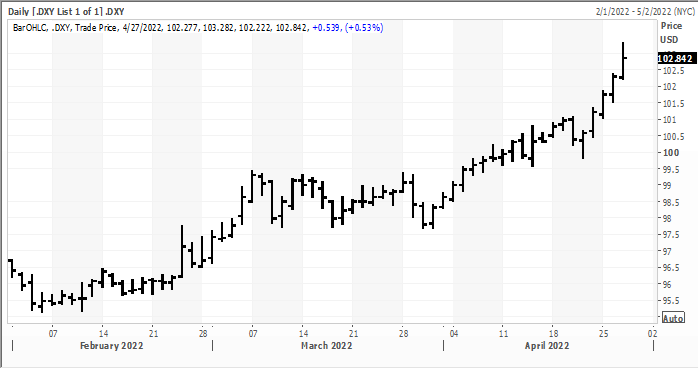
Source:
Reuters and FI
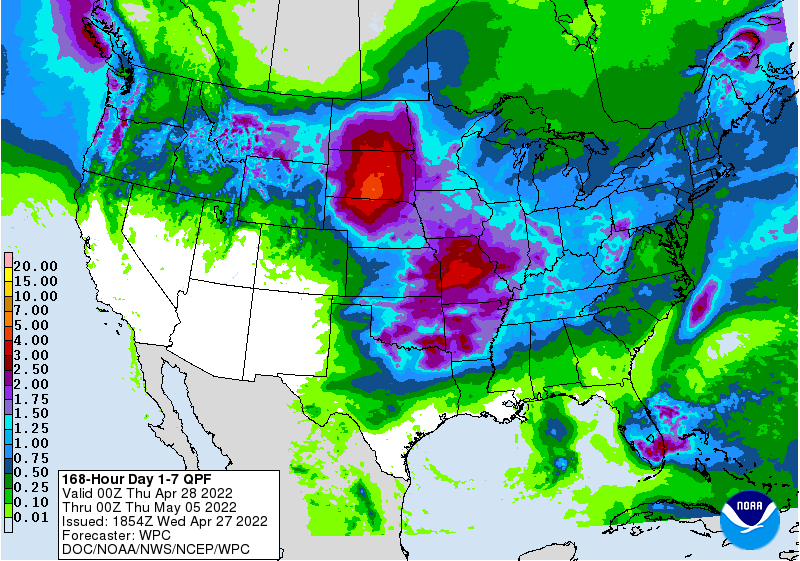
WEATHER
EVENTS AND FEATURES TO WATCH
- Spring
planting delays will remain the greatest issue of the day today in the U.S. northern Plains and Midwest with some disruption possible in parts of the Delta and southeastern states as well - Moisture
that falls in the lower Delta and southeastern states will be good for developing crops especially since precipitation in those areas is expected to be infrequent, brief and light - Southwestern
U.S. Plains will get some rain this weekend offering a little reprieve from dryness - Moisture
totals of 0.25 to 0.75 inch and local totals over 1.00 inch will be possible in the Texas Panhandle, western Oklahoma and southern Kansas while some greater rain occurs in central Oklahoma - Some
follow up precipitation may occur briefly next week - The
bottom line will be some short-term crop improvement for winter wheat, oats and canola produced in the region - West
Texas cotton, corn, sorghum and peanut country will only see precipitation in the Low Plains and Rolling Plains in this coming week - Southwestern
dryland areas will not likely get significant precipitation - Showers
and thunderstorms will be most likely from the Abilene and Wichita Falls, Texas region into the Texas Panhandle and western Oklahoma clipping only a few of the northeastern most counties of West Texas proper - Western
Oklahoma and the Rolling Plains of Texas should be wettest - South
Texas showers and thunderstorms Tuesday and early this morning produced highly varying amounts of rain with some heavy amounts near the Rio Grande and from the southern Blacklands to the upper Texas Coast where Doppler Radar suggested rainfall of 1.00 to more
than 3.00 inches resulted - The
Texas Coastal Bend area, through reported less than 0.20 inch. - Very
little follow up precipitation is expected for a while - U.S.
southeastern states will receive below normal precipitation during the next two weeks especially in southern Georgia, Florida, South Carolina and southeastern Alabama - U.S.
Midwest rainfall will become frequent this weekend and last for about ten days resulting in a lengthy period of restricted field progress - Temperatures
will be cooler than usual keeping drying rates between rain events slow - Frequent
precipitation in the northern U.S. Plains will perpetuate flood conditions in North Dakota and neighboring areas of Manitoba, Canada - Additional
moisture in Montana and the western Dakotas will be great for use during the spring growing season, but some delay in fieldwork is likely until then - Precipitation
in the U.S. Pacific Northwest will be a little more restricted over the next ten days, but mountainous areas will get moisture while the Yakima and Colombia River Basins see more limited precipitation potential - U.S.
far west will continue dry from central and southern California through the southwestern desert region where cotton and other crops are grown - Southwestern
Canada’s Prairies will continue to see restricted rainfall over the next ten days maintaining concern over crop development and production potentials this year - Relief
from dryness is still expected late this spring and into the summer - Ontario
and Quebec, Canada will see a frequent occurrence of precipitation that should support planting and early season crop development from the middle of May through June - Concern
about Mato Grosso, Brazil Safrinha corn and cotton will continue over the next ten days - Some
showers are advertised early next week, but early indications suggest rainfall of 0.20 to 0.75 inch with a few local totals to 1.00 inch - Crop
moisture stress will rise until that precipitation evolves and once the showers begin, they may prove to be a little too light for a serious change in crop or field conditions - Drier
weather will resume during the second half of next week limiting the amount of benefit that will come
- Western
Argentina is still drying down, but summer crops are not being harmed by the pattern - Rain
will be needed in the second half of May and June to support winter wheat and other winter crops that get planted at that time; until then, there is not much reason for concern over dryness - Waves
of rain will impact southern Paraguay, eastern Argentina, Uruguay and far southern Brazil during the next ten days maintaining wet field conditions in those areas - The
region to be impacted will include the south half of Parana and southern Paraguay into Chaco, Santa Fe and eastern Buenos Aires, Argentina
- Fieldwork
will be slowed in these areas and some crop quality concerns will arise over time - Frequent
rain from the northern half of the Amazon River Basin through Colombia, western Venezuela and Ecuador to parts of Central America will induce local areas of flooding in the next ten days - Europe
precipitation will occur most often from Spain, Portugal and parts of southern France into southern Belarus, central and western Ukraine and parts of western Russia over the next ten days to two weeks
No
heavy rain is expected, but enough will fall to support winter and spring crop development
- Some
disruption to fieldwork will be possible periodically - Temperatures
in Europe and the western CIS are expected to be near to below normal during the next ten days while the eastern CIS New Lands and Kazakhstan are warmer than usual - Parts
of Central Asia will also be quite warm - Western
Commonwealth of Independent States weather will include frequent bouts of rain, drizzle and some snow during the next ten days - Soil
moisture will continue rated adequate to excessive with areas from southern Belarus and northwestern Ukraine into the middle Ural Mountains region wettest and carrying the greatest need for drier weather - Fieldwork
will advance a little slower than usual in some areas because of wet field conditions and some occasional precipitation. Drier and warmer weather would be best in promoting fieldwork, but big changes are not very likely for a while - India
weather will remain normal for this time of year - Bouts
of rain will occur from West Bengal through Bangladesh to the far Eastern States
- Some
showers will also occur in far southern India, but they should be brief and very light
- Harvest
progress should advance well - North
Africa rainfall over the next ten days will be greatest in northern Algeria and northern Tunisia where some areas will receive 1.00 to 3.00 inches while others receive 0.25 to 0.75 inches - Morocco
and Tunisia will be driest with only a few sporadic showers - North
central Algeria will be wettest - Conditions
will be good for reproducing and filling winter crops - West-central
Africa rainfall is expected to be frequent over the next ten days maintaining a very good environment for coffee, cocoa, sugarcane, citrus and some cotton - A
boost in rainfall would be welcome in cotton areas - South
Africa rainfall should be a little less frequent and less significant in this coming week to ten days relative to that of last week - The
nation needs net drying to support better summer crop maturation and harvest conditions - Too
much moisture in recent weeks has delayed harvesting and reduced cotton and some oilseed quality - Crop
maturation and harvest conditions should improve - China
weather is expected to be relatively normal for this time of year, during the next ten days to two weeks - Rain
frequency will be greatest near and south of the Yangtze River - Precipitation
in the Yellow River Basin and North China Plain will be most limited and net drying is expected, but that is not unusual for this time of year - A
brief bout of rain is expected in the coming week to offer a short-term break from the recent drying trend, but more rain will be needed
- Heilongjiang
will also be wetter biased with precipitation both early this week and again during the weekend - Soil
temperatures are warm enough to plant spring wheat and sugarbeets in the northeast of China and warm enough for some corn planting across east-central parts of the nation. Fieldwork should advance around anticipated rainfall.
- Recent
soil assessments show the Yellow River Basin and North China Plain becoming a little too dry, but much of the winter crop is irrigated and there will be some timely rainfall in the next ten days that should maintain a good outlook for winter crop and spring
crops - Planting
is advancing swiftly after recent warm and dry biased conditions - China’s
rapeseed crops is in mostly good condition, but a close watch on rainfall is warranted because of the threat frequent rain might have on crop quality and harvest progress next month - Australia
rainfall Tuesday was greatest in northern New south Wales where 0.60 to 1.30 inches resulted through dawn today - The
impact was low, but harvest delays resulted - Rain
in eastern Australia will linger in New South Wales today, but Thursday will be dry before another bout of moisture arrives Friday into the weekend.
- The
moisture will be good for future wheat, barley and canola planting this autumn while not quite so welcome in summer crop areas where harvest progress is under way - Some
Central New South Wales locations will receive 1.00 to 2.50 inches of rain between today’s rain event and that of this weekend
- Cotton
quality might be briefly compromised - Portions
of Kazakhstan have need for more moisture and the region should be closely monitored for dryness later this growing season - Xinjiang,
China precipitation is expected to continue mostly in the mountains, but the precipitation will improve spring runoff potentials in support of better irrigation water supply - Turkey,
Iran and northern Afghanistan will be the wettest Middle East countries over the next ten days - Rain
is still needed in Syria, Iraq and neighboring areas to the south - Southeast
Asia rainfall is expected to be abundant in Indonesia, Malaysia and Philippines while a little erratic in the mainland crop areas during the next ten days - Overall,
crop conditions will remain favorable - A
developing tropical cyclone is expected over the southern Philippines the next few days that will evolve into a tropical storm later in the week over the South China Sea
- Some
moderate to locally heavy rainfall is likely in the central and southern Philippines over the next couple of days as the disturbance pushes through central areas - The
tropical cyclone could move across Luzon island or Taiwan early during the middle part of next week after becoming better organized in the South China Sea this weekend - Confidence
is low - Eastern
Mexico will receive sporadic showers over the coming week - Western
areas will be dry biased - Recent
rain in the east has improved soil moisture to some crop areas - Central
America precipitation will slowly expand northward in the next few weeks - the
moisture will be good for most crops - Today’s
Southern Oscillation Index was +18.61 and it will continue rising for a while longer.
- New
Zealand weather has been mostly good recently, but central parts of the nation have been drier than usual and precipitation in the next ten days will be very limited
Source:
World Weather Inc.
Bloomberg
Ag Calendar
- EIA
weekly U.S. ethanol inventories, production, 10:30am - Geneva
Sugar Conference, day 2 - EARNINGS:
Bunge, Pilgrim’s Pride
Thursday,
April 28:
- USDA
weekly net-export sales for corn, soybeans, wheat, cotton, pork and beef, 8:30am - Brazil’s
Conab releases production numbers for sugar, cane and ethanol (tentative)
Friday,
April 29:
- ICE
Futures Europe weekly commitments of traders report - CFTC
commitments of traders weekly report on positions for various U.S. futures and options, 3:30pm - Vietnam’s
General Statistics Office releases coffee, rice and rubber export data - FranceAgriMer
weekly update on crop conditions - U.S.
agricultural prices paid, received, 3pm - HOLIDAY:
Japan, Indonesia
Source:
Bloomberg and FI
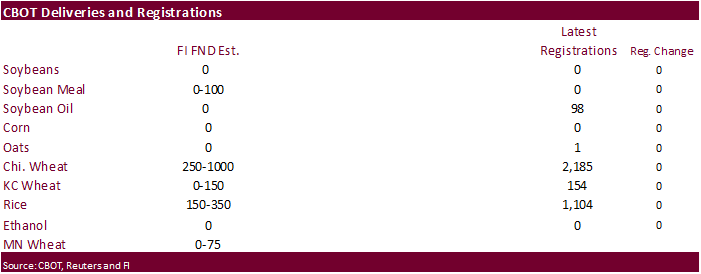
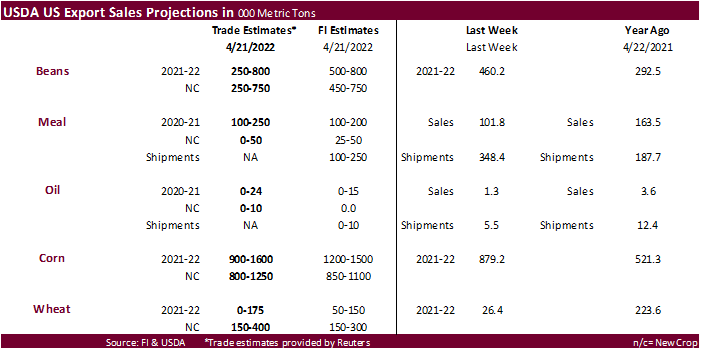
US
Wholesale Inventories (M/M) Mar P: 2.3% (est 1.5%; prev 2.5%)
US
Advance Goods Trade Balance Mar: -$125.3Bln (est -$105.0Bln; prev -$106.6Bln; prevR -$106.3Bln)
US
Retail Inventories (M/M) Mar: 2.0% (est 1.4%; prev 1.1%)
US
DoE Crude Oil Inventories (W/W) 22-Apr: +691K (est 0K; prev -8020K)
–
Distillate Inventories: -1449K (est -1000K; prev -2664K)
–
Cushing OK Crude Inventories: +1298K (prev -185K)
–
Gasoline Inventories: -1573K (est 1000K; prev -761K)
–
Refinery Utilization: -0.70% (est 0.00%; prev 1.00%)
EIA:
US Distillate Inventories Fell To Lowest Since May 2008 In Latest Week
84
Counterparties Take $1.803 Tln At Fed Reverse Repo Op (prev $1.819 Tln, 84 Bids)
·
July corn traded in a wide two-sided range, ending on a strong note led by nearby contracts. Funds bought an estimated net 9,000 contracts. The rally in the USD initially pressured corn but that fizzled away after wheat started
to pair losses and soybeans rallied.
·
News was light and global corn export developments are slowing.
·
Argentina producers sold 880,000 tons of corn for the week ending April 20, bringing 2021-22 sales to 22.6 million tons, near the same about at this time last year.
·
China plans to buy another 40,000 tons of pork for state reserves on April 29, sixth such purchase this year.
·
The USDA Broiler Report showed eggs set in the US up slightly and chicks placed up slightly from a year ago. Cumulative placements from the week ending January 8, 2022, through April 23, 2022 for the United States were 2.98 billion.
Cumulative placements were down slightly from the same period a year earlier.
·
We lowered our 2021-22 US corn for ethanol use from 5.400 billion bushels to 5.380 billion, 5 million above USDA.
Iowa
lawmakers OK bill mandating sale of E15 at gas stations
https://apnews.com/article/business-iowa-kim-reynolds-cc6bd64ce6e80a2b9e55d85066b92c6d
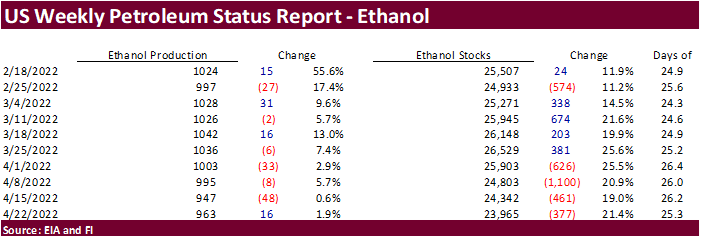
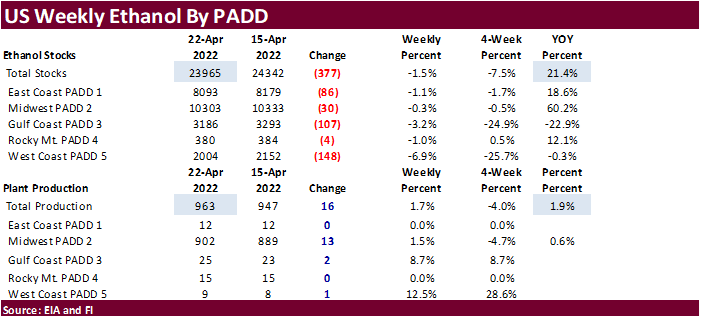
Potential
Disruptions in Nitrogen Fertilizer Trade
Schnitkey,
G., C. Zulauf, K. Swanson, N. Paulson and J. Baltz. “Potential Disruptions in Nitrogen Fertilizer Trade.”
farmdoc
daily
(12):57, Department of Agricultural and Consumer Economics, University of Illinois at Urbana-Champaign, April 26, 2022.
https://farmdocdaily.illinois.edu/2022/04/potential-disruptions-in-nitrogen-fertilizer-trade.html
Export
developments.
·
None reported
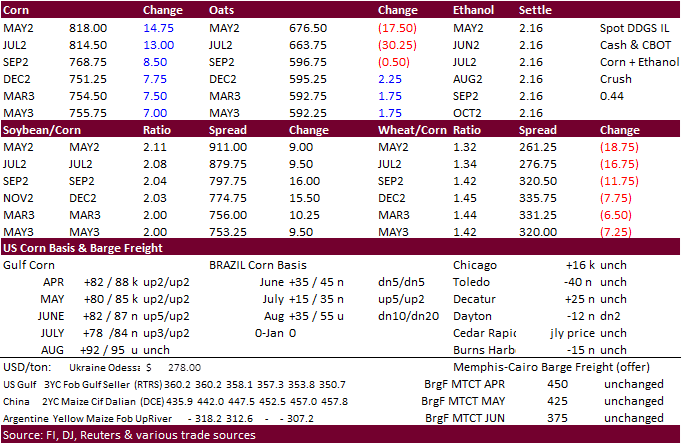
Updated
4/22/22
July
corn is seen in a $7.25 and $8.65 range
December
corn is seen in a wide $5.50-$8.50 range (unchanged, up 50 cents high end)
·
Soybean oil traded sharply higher on Indonesia palm oil export ban concerns and a large rally in the palm oil market. Malaysian palm oil hit a 7-week high. July CBOT oil share hit a record contract high, settling near 49.03%.
Soybeans and meal settled higher after seeing a two-sided trade. The Indonesia palm oil export ban starts Thursday. Today Indonesia widened their list of products, including crude palm oil, to the export ban. Selected RBD and cooking oils were already considered.
·
Funds bought an estimated net 11,000 soybeans, 4,000 soybean meal and 9,000 soybean oil.
·
July soybean meal tested its 100-day MA and bounced off of it, then rallied to trade higher. Much of this was technical buying after CBOT soybean meal futures prices broke earlier this week. Adding to the positive undertone was
South Korea taking advantage of the price drop by buying a combined 119,000 tons of soybean meal, at about $20/ton cheaper than what NOFI paid earlier this week.
·
The CBOT nearby crush firmed with the rally in soybean oil, with July up 14 cents to $2.1050.
·
(Reuters) – Indonesia’s planned export ban on cooking oil’s raw material will cover crude palm oil, refined palm oil and used cooking oil, among other palm oil products, its chief economic minister said on Wednesday. The announcement
was a reversal of the minister’s statement a day earlier, in which he had said the export ban would only cover refined, bleached, and deodorized palm olein. The ban comes into force at midnight (1700 GMT Wednesday).
·
Argentina producers sold 13.6 million tons so far for the 2021-22 crop-year, compared to 15.5 million tons year earlier.
·
Malaysia is on holiday May 2-4, returning May 5.
·
South Korean groups FLC and MFG bought 59,000 tons and 60,000 tons of soybean meal, respectively, at $571.95/ton C&F and $569.30/ton, for September arrival. Earlier this week NOFI paid $591.80.
·
Egypt’s GASC seeks vegetable oils for June and/or July arrival on Thursday, April 28. A minimum of 30,000 tons of soybean oil and 10,000 tons of sunflower oil, in the international market, is for arrival between June 10 and 30.
Locally they seek 3,000 tons of soybean oil and 2,000 tons of sunflower oil with delivery from June 10 to 30.
·
Turkey seeks 18,000 tons of sunflower oil on April 28 for shipment between May 16 and June 16.
·
China looks to auction off another 500,000 tons of soybeans April 29.
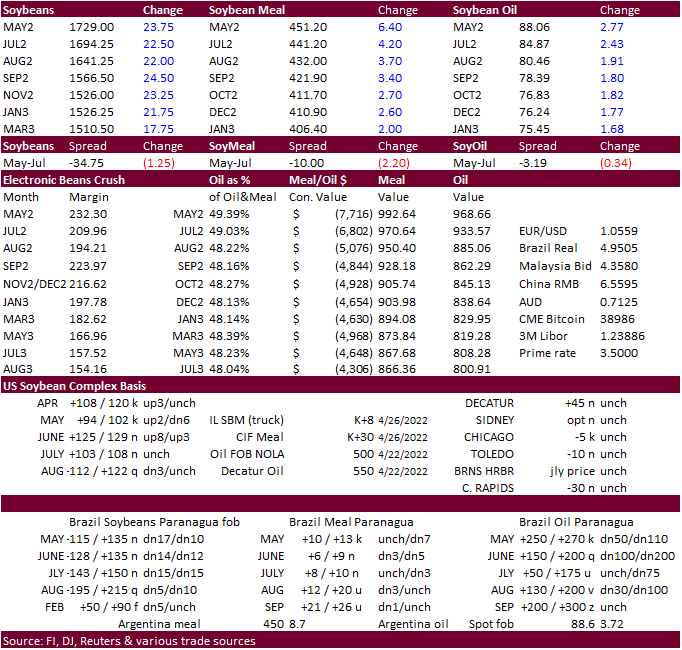
Updated
4/22/22
Soybeans
– July $16.00-$18.50
Soybeans
– November is seen in a wide $12.75-$16.50 range (unchanged, up $1.00 high end)
Soybean
meal – July $420-$5.20
Soybean
oil – July 75-90
·
US wheat traded
two-sided, ending lower in the nearby contracts for Chicago, lower for KC, and higher for Minneapolis. The USD was up again, by 63 points by 1:25 pm CT. Chicago and KC were under pressure from profit taking and technical selling. MN found strength on slow
seeding progress for US and Canadian spring wheat and Algeria picking up at least 230,000 tons of durum wheat. Taiwan passed on feed wheat. A weaker euro supported Paris wheat futures.
·
Funds sold an estimated net 2,000 soft red winter wheat contracts.
·
September EU wheat futures were 3.75 euros higher at 378.25 euros.
·
Russia announced they are ready to increase wheat shipments to Africa.
·
Algeria bought at least 230,000 tons of Mexican durum wheat for second half of May and June shipment at around $570 a ton c&f for shipment in large panama bulk carriers and about $590 a ton for shipment in smaller handysized vessels.
·
Thailand passed on feed wheat for June-October shipment. Lowest offer was around $380/ton c&f.
·
Jordan passed on 120,000 tons of wheat for Jun and/or Aug shipment.
·
Jordan seeks 120,000 tons of feed barley on May 10 for Aug/Sep shipment.
·
Turkey seeks 210,000 tons of international red milling wheat on Friday and another 210,000 tons of wheat already in warehouses for delivery between May 17 and August 10.
Rice/Other
·
None reported
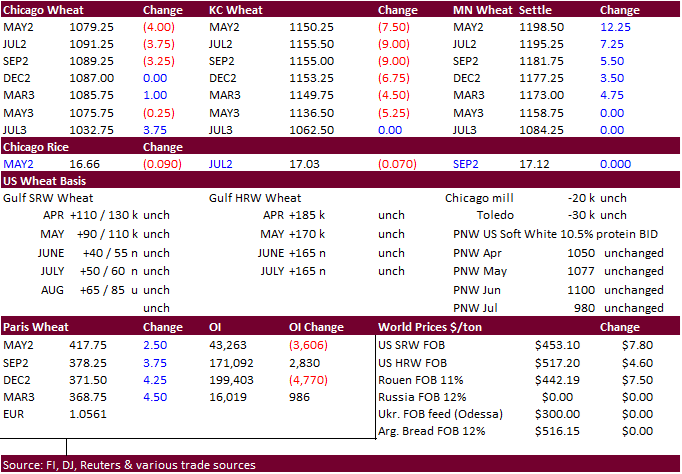
Updated
4/22/22
Chicago – July $10.50 to
$12.50 range, December $8.50-$12.50
KC – July $10.25 to $12.50
range, December $8.75-$13.50
MN – July $10.75‐$13.00,
December $9.00-$14.00
Terry Reilly
Senior Commodity Analyst – Grain and Oilseeds
Futures International
One Lincoln Center
18 W 140 Butterfield Rd.
Oakbrook Terrace, Il. 60181
W: 312.604.1366
ICE IM:
treilly1
Skype: fi.treilly

Trading of futures, options, swaps and other derivatives is risky and is not suitable for all persons. All of these investment products are leveraged, and you can lose more than your initial deposit. Each investment product is offered
only to and from jurisdictions where solicitation and sale are lawful, and in accordance with applicable laws and regulations in such jurisdiction. The information provided here should not be relied upon as a substitute for independent research before making
your investment decisions. Futures International, LLC is merely providing this information for your general information and the information does not take into account any particular individual’s investment objectives, financial situation, or needs. All investors
should obtain advice based on their unique situation before making any investment decision. The contents of this communication and any attachments are for informational purposes only and under no circumstances should they be construed as an offer to buy or
sell, or a solicitation to buy or sell any future, option, swap or other derivative. The sources for the information and any opinions in this communication are believed to be reliable, but Futures International, LLC does not warrant or guarantee the accuracy
of such information or opinions. Futures International, LLC and its principals and employees may take positions different from any positions described in this communication. Past results are not necessarily indicative of future results.
